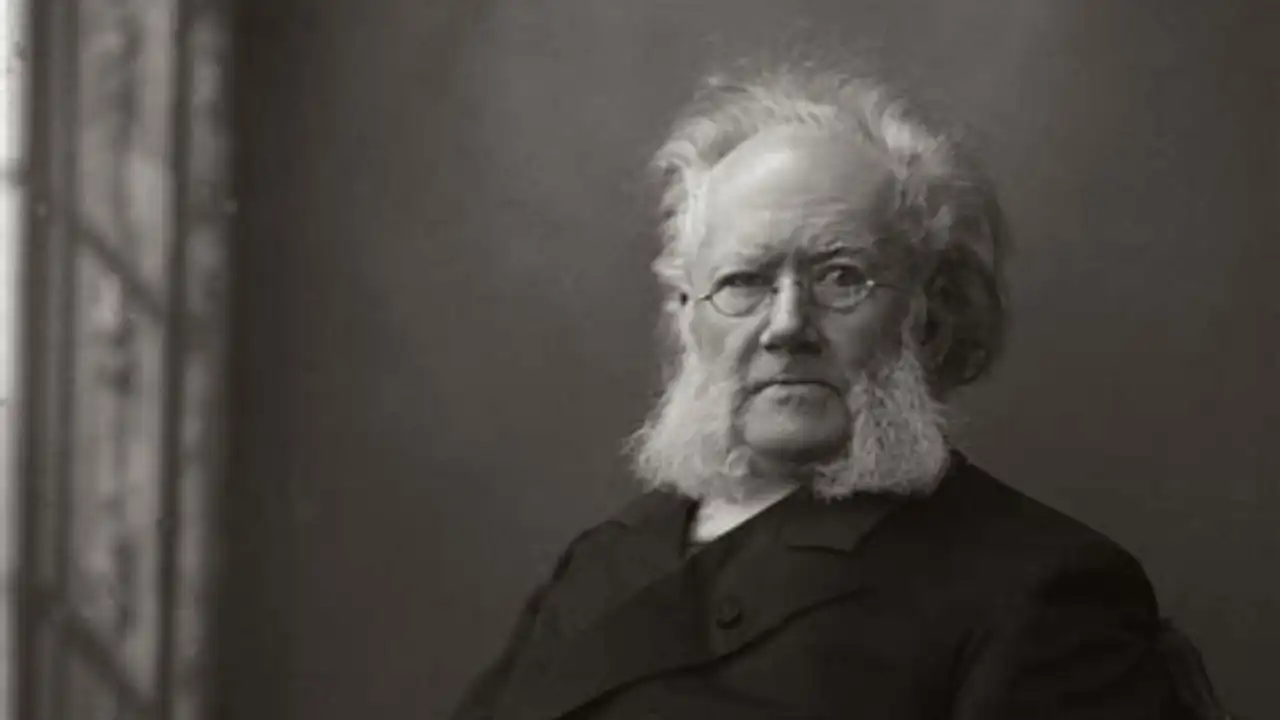Henrik Ibsen
Henrik Ibsen (1828–1906) is considered one of the most important playwrights of the 19th century and a pivotal figure in the development of modern drama. His work is characterized by its exploration of social issues, psychological depth, and innovative dramatic techniques.
Early Life and Influences
Born in Skien, Norway, Ibsen grew up in a family that faced financial ruin when he was young. This early experience of hardship and social decline profoundly influenced his worldview and later works. After moving to Grimstad as a teenager, Ibsen worked as an apprentice pharmacist, a job that allowed him time to write. His early plays were heavily influenced by Norwegian folklore, historical events, and the works of Shakespeare.
Career and Major Works
Ibsen’s career can be divided into several phases:
Early Plays (1850s-1860s):
- “Catiline” (1850): His first play, heavily influenced by his classical studies.
- “The Feast at Solhaug” (1856) and “The Vikings at Helgeland” (1858): These works draw on Norwegian history and legend.
Exile and Breakthrough (1864-1891):
Ibsen left Norway in 1864, spending most of his time in Italy and Germany. This period was crucial for his development as a playwright.
- “Brand” (1865): A dramatic poem that explores themes of idealism and sacrifice.
- “Peer Gynt” (1867): A poetic play combining folklore and satire, examining human nature and the search for identity.
- “The Pillars of Society” (1877): Marks the beginning of his realistic plays, focusing on societal hypocrisy.
Major Realistic Plays (1879-1899):
- “A Doll’s House” (1879): Examines the limitations placed on women in society and the sacrificial role expected of them. The play ends with the protagonist, Nora, leaving her husband and children to find her own identity, a shocking conclusion for its time.
- “Ghosts” (1881): Tackles issues such as hereditary illness, moral hypocrisy, and the constraints of social expectations.
- “An Enemy of the People” (1882): Centers on the struggle between the individual and the collective, highlighting issues of public health and integrity.
- “The Wild Duck” (1884): A complex exploration of reality versus illusion and the impact of hidden truths on family life.
- “Rosmersholm” (1886) and “Hedda Gabler” (1890): Focus on the psychological conflicts and societal pressures faced by their protagonists.
Late Plays (1891-1900):
- “The Master Builder” (1892), “Little Eyolf” (1894), “John Gabriel Borkman” (1896), and “When We Dead Awaken” (1899): These plays delve into themes of ambition, regret, and the search for meaning in life.
Themes and Techniques
Themes:
- Social Critique: Ibsen’s plays often critique the moral rigidity and hypocrisy of society, especially regarding gender roles, marriage, and the individual’s role within the community.
- Psychological Depth: He delves into the motivations and inner conflicts of his characters, revealing the complexities of the human psyche.
- Reality vs. Illusion: Many of his plays explore the tension between how things appear and the underlying truths, often exposing societal and personal illusions.
- Individual vs. Society: Ibsen frequently examines the struggles of individuals who challenge societal norms and the consequences they face.
For more details read: Themes in Henrik Ibsen’s works
Techniques:
- Realism: Ibsen is known for his realistic dialogue and settings, focusing on everyday life and believable characters.
- Symbolism: He uses symbols to add deeper layers of meaning to his plays, such as the tarantella dance in “A Doll’s House” or the wild duck in “The Wild Duck.”
- Structure: His plays often follow a tight, well-constructed narrative that builds tension and leads to a dramatic climax.
- Subtext: Ibsen’s dialogue often carries multiple layers of meaning, with much of the conflict and emotion conveyed through what is unsaid.
Influence and Legacy
Ibsen’s work had a profound impact on the development of modern drama. He influenced playwrights like George Bernard Shaw, Anton Chekhov, and later, Arthur Miller and Tennessee Williams. His exploration of social issues and the human condition helped pave the way for 20th-century realism and modernist drama.
Notable Quotes
- “The strongest man in the world is he who stands most alone.” — “An Enemy of the People”
- “A thousand words will not leave so deep an impression as one deed.” — “The Pillars of Society”
- “The majority is always wrong; the minority is rarely right.” — “An Enemy of the People”
Critical Reception
Ibsen’s work was often controversial. “A Doll’s House” was considered scandalous for its portrayal of a woman rejecting her traditional role. “Ghosts” faced fierce backlash for its candid discussion of venereal disease and moral corruption. Despite initial resistance, Ibsen’s plays gained recognition for their bold exploration of contemporary issues and their artistic innovation.
Critics like George Bernard Shaw praised Ibsen for his unflinching examination of social issues and his revolutionary impact on theatre. Others criticized him for what they saw as his pessimism and focus on societal problems. Over time, however, Ibsen has come to be celebrated as a foundational figure in modern drama, whose works continue to be relevant and thought-provoking.
